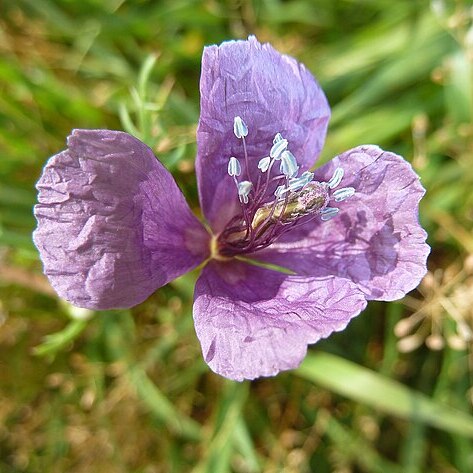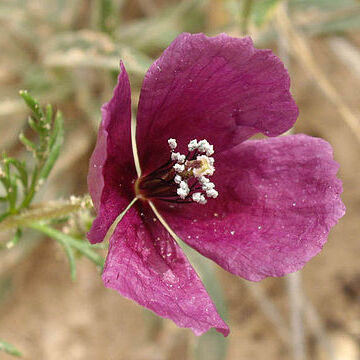Herbs, annual, 10-50 cm tall. Stems erect, terete, few branched, nearly glabrous. Basal leaves several, glabrous or slightly bristly; petiole long, basally with inflated sheath; blade ovate, bipinnatilobate to tripinnatilobate; lobules linear, apex acute or almost acute, rarely obtuse. Cauline leaves similar to basal leaves, but smaller and shortly petiolate to almost sessile. Flowers solitary, terminal or axillary, short-lived, petals generally dropping by afternoon. Pedicel 5-7.5 cm. Flower buds oblong-ovoid, ca. 1 cm, outside pubescent, apically rounded. Sepals caducous, ovate, pubescent. Petals purple, broadly ovate to suborbicular, 1.5-3 cm. Stamens numerous; filaments deep purple; anthers yellow. Ovary terete; styles short; stigmas capitate, 4-lobed, lobes suborbicular. Capsule narrowly terete, 5-10 cm, only apically sparsely setaceous, when mature usually 4-valvate from apex to base. Seeds many, reniform, adaxially alveolate. 2n = 22, 24.
More
Plant to 0.5 m high, glabrescent to sparsely setose. Stems simple or usually branching. Leaves to 8 cm long; petiole to 1.5 cm long; lamina bipinnately or tripinnately divided; margin entire; ultimate segments lanceolate to linear, usually tipped with short, delicate bristles. Peduncle to 8 cm long. Petals to 2.5 cm long, violet. Stamens: filaments blackish; anthers blue. Capsule straight to slightly curved, to 10 cm long, glabrous to sparsely hispid or setose; valves tipped with short, usually hispid ligules not extending beyond stigmas. Seeds grey, reticulate-pitted.


